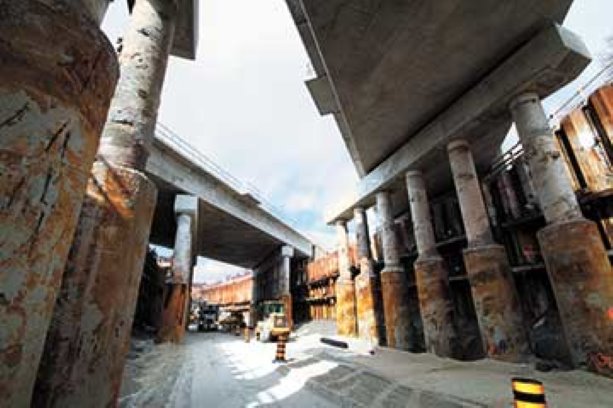A 3,800-cubic-metre concrete storm water retention tank, which will be installed under a road in a densely populated area of west end Toronto, may not be the first of its kind but it is being heralded as an innovative solution.
The retention tank could solve some potentially complicated drainage issues stemming from improvements on a section of the GO Train corridor linking downtown Toronto to Georgetown, Ont.
Designed by R.V. Anderson Associates Limited, the 140-metre-long, 9.75-metre wide, and 2.74-(internal) high tank will divert storm water and surface run off from a nine-hectare catchment area. It is being placed directly beneath the new Denison Road underpass by Dufferin Construction.
Once operational, a computerized dewatering station consisting of a three-metre-diameter precast concrete shaft and two 15-metre-deep submersible pumps will divert water from the tank — at a controlled rate — into the Denison Road West storm sewer.
However, that can only be done at certain times. Due to basement flooding concerns in the area, no water will be allowed into the storm sewer during wet weather when it reaches its capacity, says Mark Hagesteijn, senior associate with Anderson Associates.
A number of catchbasins and an oil grit separator after the pumping station will help catch debris and pollutants before water flows from the storm drain into the nearby Humber River. As well, sediment in the tank will have to be periodically removed, says Hagesteijn.
An important design and functional feature of the tank is its size “which can accommodate run off from a 100-year-storm.”
Even so, the higher portion of the Denison Road underpass will have parallel three metre-wide pedestrian walkways which will allow emergency vehicles to pass through if the 100-year-threshold is ever exceeded, says Hagesteijn.
The catalyst and the need for the tank is the Georgetown South Project. This is actually a series of projects being implemented by the GO Transit division of Metrolinx, the agency co-ordinating transit planning in the Greater Toronto Hamilton Area, to improve GO Train service. Through track sharing, it also allows for the new Union Pearson Express between Toronto’s Union Station and Lester B. Pearson International Airport, says GO.
As part of those improvements, two new railway bridges have been constructed side-by-side over Denison Road. The first is a 43-metre-long, 18-metre-wide, four-track bridge for GO train use. The second is a 45-metre-long, 10-metre wide, two- track CPR bridge.
In tandem with the bridge construction, Denison Road has been lowered approximately eight metres to form an underpass.
Underpasses, like the Denison Road one, and overpasses are being built along the corridor “to separate road and rail traffic given the increase in transit trips and to improve the on time performance of our transit service,” says Manuel Pedrosa, GO’s community relations manager for the project.
But lowering the road also meant it would be vulnerable to flooding. As storm water couldn’t be drained away by conventionally-gravity operated storm, an alternative solution had to be found, says Vireak Hinh, R.V. Anderson Associates structural engineer.
That solution was the tank. However, as the area is quite built up, it had to be buried under the road and designed so that could fit within the narrow confines of the road allowance. The design took approximately a year to complete, he says.
Pouring of the concrete slab for the tank was scheduled to start in April and later this year Dufferin Construction will install approximately 80-already fabricated segments to form a one-piece wall and roof cover, says Hinh.



Recent Comments
comments for this post are closed